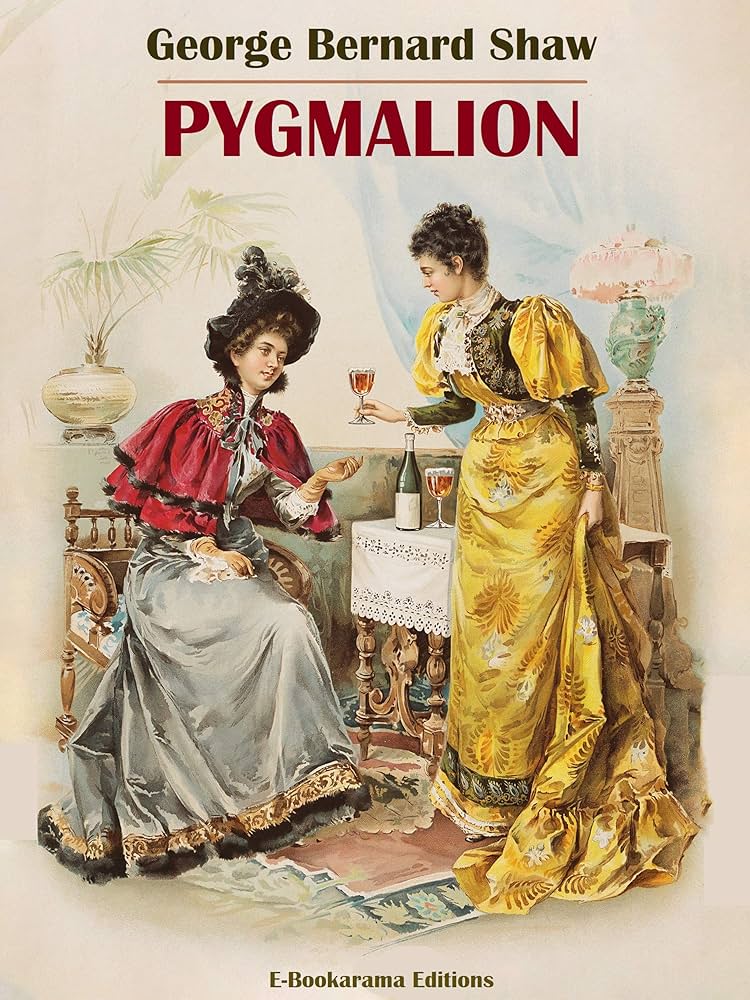Table of Contents
A Play Beyond the Stage
George Bernard Shaw’s Pygmalion is a masterstroke of wit and social critique disguised as a romantic comedy. Written as a stage play but read today with the enduring force of fiction, Pygmalion deconstructs class structures, mocks pretensions, and questions the transformative power of language and education.
Though best known to modern audiences through its musical adaptation My Fair Lady, Shaw’s original is far more radical and nuanced. It’s not a Cinderella story. It’s an intellectual duel that turns a simple flower girl into a mirror that reflects the absurdities of Edwardian society—and still resonates with readers today.
Plot Summary: Phonetics Meets Social Climbing
The plot centers on Eliza Doolittle, a Cockney flower seller with poor grammar and strong street smarts. Professor Henry Higgins, a phonetician with a fascination for dialects and a disdain for decorum, makes a bet with his friend Colonel Pickering: he can train Eliza to pass as a duchess by teaching her proper speech.
What begins as a linguistic experiment evolves into a volatile, often comical confrontation between self-worth, societal expectations, and identity. Eliza’s transformation is undeniable—but so is the cost. As her elocution improves, her independence and dignity are put to the test.
Unlike romantic adaptations, Shaw offers no easy resolution. Pygmalion ends not in marriage, but in ambiguity, challenging both the genre and the audience.
Themes: Class, Identity, and the Politics of Speech
1. Language as a Tool and a Trap
Shaw’s greatest insight lies in his treatment of language—not just as a communication tool but as a gatekeeper of social mobility. Eliza’s ascent into high society is enabled not by wealth or lineage, but by diction. Yet this transformation is superficial; her accent may fool aristocrats, but it can’t erase her past or guarantee agency.
2. Class and Artificiality
Shaw ridicules the rigidity of class systems. Characters like the Eynsford Hills show how mannerisms can obscure financial insecurity, while Eliza’s father Alfred Doolittle ascends to the middle class and laments its burdens. Class, Shaw argues, is a performance—one as constructed as any phonetic exercise.
3. Feminism and Autonomy
Eliza emerges as more than a student. She asserts her independence, demanding recognition not just as a subject but as a person. Shaw’s Eliza is no passive Cinderella; she questions her makers, reclaims her voice, and ultimately walks away from both romantic and intellectual domination.
4. Transformation with Consequences
Unlike the myth of Pygmalion and Galatea, Shaw’s Eliza is not molded into an ideal wife. She is shaped, yes—but the sculptor has no control over the soul he awakens. The real transformation belongs to her, not him.
Style and Dialogue: Razor-Sharp Wit and Social Satire
Shaw’s strength lies in his dialogue. Every exchange crackles with irony, intellectual tension, or humor. Professor Higgins, rude and brilliant, is both entertaining and exasperating. Eliza, vulnerable and sharp-tongued, gradually matches his verbal agility.
Stage directions are unusually rich—Shaw uses them to deliver authorial asides, critique characters, and insert social commentary. These notes transform the reading experience into a hybrid of fiction and essay.
The play’s satire is as pointed today as it was in 1913. Shaw punctures Victorian morality, mocks bourgeois etiquette, and resists tidy endings.
Character Analysis: No Heroes, Just Humans
- Eliza Doolittle – The beating heart of the play. Her journey from flower girl to articulate individual is not just about voice but about self-worth. She is proud, perceptive, and refuses to be owned.
- Professor Henry Higgins – Brilliant, childish, and callous. His intellectualism masks emotional immaturity. He is less a teacher and more an egotist playing with human clay.
- Colonel Pickering – The kinder counterpart to Higgins, though equally complicit in reducing Eliza to an experiment. He represents gentlemanly politeness without much introspection.
- Alfred Doolittle – Eliza’s dustman father provides comic relief and sharp social critique. Elevated to “middle-class morality” through accidental fortune, he becomes a reluctant symbol of the burden of respectability.
Cultural and Literary Legacy
Pygmalion continues to inspire adaptations, essays, and debates. Its transformation myth has echoed through musicals, films, and classrooms. But it’s also been misinterpreted—often romanticized or diluted.
Shaw fought hard against happy-ending interpretations. His postscript essay, “What Happened Afterwards,” makes it clear: Eliza does not marry Higgins. She marries Freddy, a weaker match but one that allows her dignity. Shaw insisted that transformation must not come at the cost of subjugation.
In academia, Pygmalion is celebrated not just as a play, but as a work of fiction with intellectual depth—one that uses theatricality to advance sociological inquiry.
Symbolism and Subtext
- Pygmalion Myth: Higgins as sculptor and Eliza as creation—except here, the statue talks back. The original myth is inverted; Galatea leaves the sculptor.
- Clothing and Cleanliness: External transformation symbols—Eliza’s bath and new clothes—highlight how society judges worth by appearance and accent, not substance.
- The Phonograph: A machine that records voices mirrors Higgins’ mechanistic view of Eliza. But while the phonograph repeats, Eliza evolves.
Key Takeaways
- Pygmalion is not a love story—it’s a war of words and wills.
- Language can elevate, but it can also alienate.
- Shaw critiques class and gender roles with precision and humor.
- Eliza’s transformation is a triumph of self-definition, not submission.
- The play is a timeless tool for examining how we define humanity, worth, and voice.
TL;DR
George Bernard Shaw’s Pygmalion remains a timeless blend of satire, intelligence, and rebellion. Beneath its comedic surface lies a deep interrogation of social constructs and personal agency. Eliza Doolittle may learn to speak like a duchess, but her real education is in self-determination.
For readers interested in sharp dialogue, feminist subtext, or the politics of language, Pygmalion offers a compact, electrifying read. It’s fiction that performs like philosophy—art that argues.

Leave a Reply